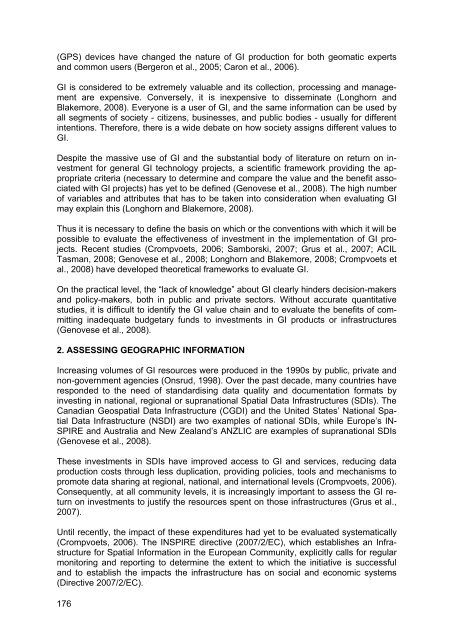SDI Convergence - Global Spatial Data Infrastructure Association
SDI Convergence - Global Spatial Data Infrastructure Association
SDI Convergence - Global Spatial Data Infrastructure Association
Create successful ePaper yourself
Turn your PDF publications into a flip-book with our unique Google optimized e-Paper software.
(GPS) devices have changed the nature of GI production for both geomatic experts<br />
and common users (Bergeron et al., 2005; Caron et al., 2006).<br />
GI is considered to be extremely valuable and its collection, processing and management<br />
are expensive. Conversely, it is inexpensive to disseminate (Longhorn and<br />
Blakemore, 2008). Everyone is a user of GI, and the same information can be used by<br />
all segments of society - citizens, businesses, and public bodies - usually for different<br />
intentions. Therefore, there is a wide debate on how society assigns different values to<br />
GI.<br />
Despite the massive use of GI and the substantial body of literature on return on investment<br />
for general GI technology projects, a scientific framework providing the appropriate<br />
criteria (necessary to determine and compare the value and the benefit associated<br />
with GI projects) has yet to be defined (Genovese et al., 2008). The high number<br />
of variables and attributes that has to be taken into consideration when evaluating GI<br />
may explain this (Longhorn and Blakemore, 2008).<br />
Thus it is necessary to define the basis on which or the conventions with which it will be<br />
possible to evaluate the effectiveness of investment in the implementation of GI projects.<br />
Recent studies (Crompvoets, 2006; Samborski, 2007; Grus et al., 2007; ACIL<br />
Tasman, 2008; Genovese et al., 2008; Longhorn and Blakemore, 2008; Crompvoets et<br />
al., 2008) have developed theoretical frameworks to evaluate GI.<br />
On the practical level, the “lack of knowledge” about GI clearly hinders decision-makers<br />
and policy-makers, both in public and private sectors. Without accurate quantitative<br />
studies, it is difficult to identify the GI value chain and to evaluate the benefits of committing<br />
inadequate budgetary funds to investments in GI products or infrastructures<br />
(Genovese et al., 2008).<br />
2. ASSESSING GEOGRAPHIC INFORMATION<br />
Increasing volumes of GI resources were produced in the 1990s by public, private and<br />
non-government agencies (Onsrud, 1998). Over the past decade, many countries have<br />
responded to the need of standardising data quality and documentation formats by<br />
investing in national, regional or supranational <strong>Spatial</strong> <strong>Data</strong> <strong>Infrastructure</strong>s (<strong>SDI</strong>s). The<br />
Canadian Geospatial <strong>Data</strong> <strong>Infrastructure</strong> (CGDI) and the United States’ National <strong>Spatial</strong><br />
<strong>Data</strong> <strong>Infrastructure</strong> (N<strong>SDI</strong>) are two examples of national <strong>SDI</strong>s, while Europe’s IN-<br />
SPIRE and Australia and New Zealand’s ANZLIC are examples of supranational <strong>SDI</strong>s<br />
(Genovese et al., 2008).<br />
These investments in <strong>SDI</strong>s have improved access to GI and services, reducing data<br />
production costs through less duplication, providing policies, tools and mechanisms to<br />
promote data sharing at regional, national, and international levels (Crompvoets, 2006).<br />
Consequently, at all community levels, it is increasingly important to assess the GI return<br />
on investments to justify the resources spent on those infrastructures (Grus et al.,<br />
2007).<br />
Until recently, the impact of these expenditures had yet to be evaluated systematically<br />
(Crompvoets, 2006). The INSPIRE directive (2007/2/EC), which establishes an <strong>Infrastructure</strong><br />
for <strong>Spatial</strong> Information in the European Community, explicitly calls for regular<br />
monitoring and reporting to determine the extent to which the initiative is successful<br />
and to establish the impacts the infrastructure has on social and economic systems<br />
(Directive 2007/2/EC).<br />
176

















